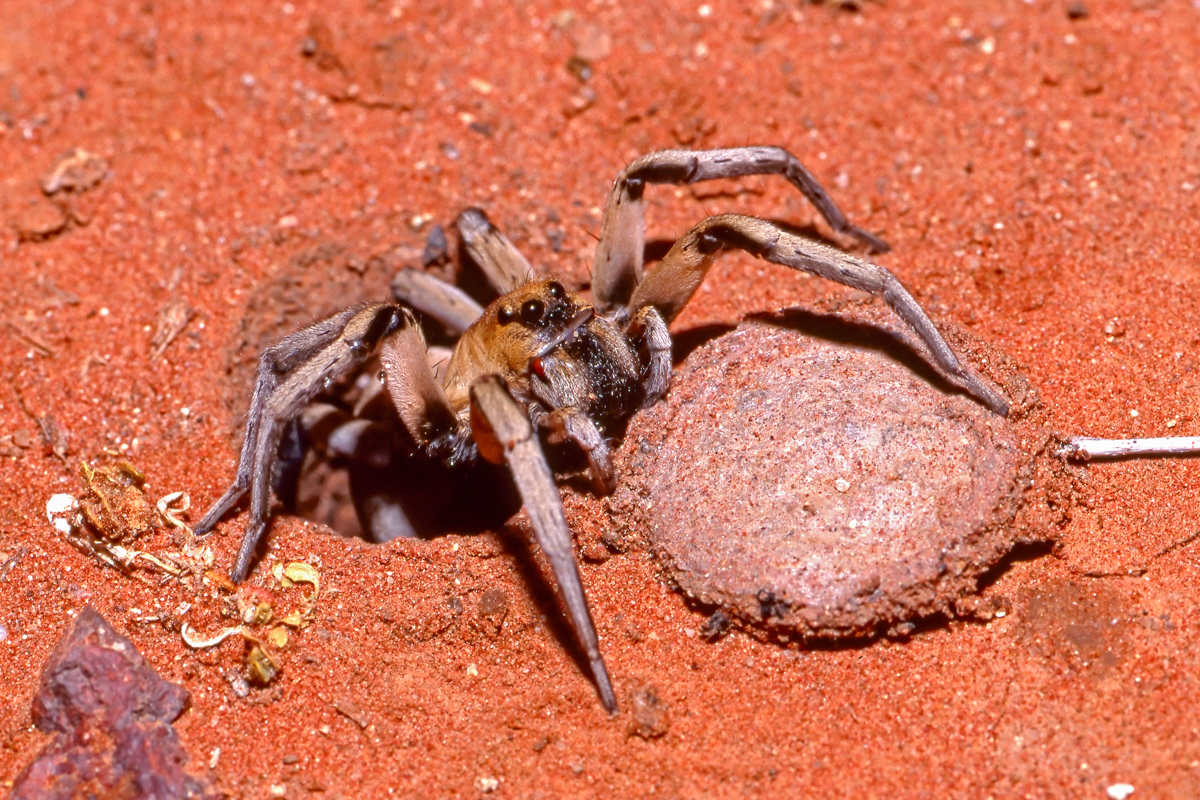Imagine a spider living to the ripe old age of forty-three, most of it within the confines of a tunnel just big enough to hold her, and allow her to turn around within. She would only come out to mate and to tend to her front door, meticulously - and to grab creatures unlucky enough to have tread (however lightly) on the twig-lines radiating from the door like spokes on a bicycle wheel.
Such was the case of a spider known as “16,” when an intrepid researcher sought to learn how long trapdoor spiders were capable of living in the wild.
Under an acacia tree in Australia, Barbara York Main identified various spider burrows with numbered markers back in the 1970s (very probably before you were even alive). She was able to document 16’s transformation from young spiderling with a dime-sized door all the way to a decades-old mature spider matriarch. Her door grew larger than a quarter and was expertly sealed to keep out driving rains, her appetite expanding with it to prey as big as rodents. Imagine!

You can read 16’s story (and see remarkable photos chronicling her journey, by Dr. Main and also Leanda Mason), here.
I recall being moved by the story the first time I read it, which is why I was so intrigued this New Year’s Day to spy a large spider at the bottom of the pool. I had already swam a few laps assuming that the black tangle beneath me at the bottom of the pool was just a clump of branches I’d have to fish out. But once I focused on it, it was obvious that it was a spider – and a big one at that.

I brought it up with a current from my foot, and since the temp in the pool was 54F, it was clear that the spider had not survived the same “cold water immersion therapy” I have been doing since October. My first thought was that it was a funnel web spider, but a quick check on my iNaturalist app came up with exactly the right result: California Trapdoor Spider. I assumed it was a female because of the sheer size of it. Check out my video, here:
Having read the article above, I was heartbroken – female trapdoor spiders can apparently live 40+ years, and this would have been a tragic end for such an interesting, wisdom-acquiring little hunter. But three things led me to believe this was actually a male:
- The spinnerets on this spider were very small. Spinnerets are the web-weaving organs of a spider, and females tend to have longer ones, for all the nest-making and baby-rearing she will do over her decades-long life. YES, “Spinneret” sounds like the spider is a member of a dance troop; I was part of a group called the Tornadoettes in high school, but that is neither here nor there.
- This spider had pedipalps that were huge! Pedipalps are the appendages by the face and in front of the legs, and although they technically serve some specific purpose like manipulating food – or in this case, applying sperm to the female – they also rub up and down over the fangs in a very adorable fashion.
- Thirdly, in the middle of drying my tears over this female’s lost mating/rearing potential I read that females don’t ever venture outside of their burrow. Like, EVER. They may mate at the door and rearrange silk strands and the surrounding grasses/twigs in a fit of sheer perfectionism and entrapment, but they don’t go looking for food, adventure, or anything else. They are not interested in travel, hence why they invest everything into making their home absolutely exquisite. By contrast, the males venture out around age six (sexual maturity) and explore until they detect the scent of a female. Mating with her becomes a dangerous game because like many female spiders, she gets hungry after mating and the male starts to look appetizing. So if he survives, he goes on to find another female until one of his mates kills him or some other creature steps on him or eats him. Basically, he mates and then dies.
- NO, I’m not an arachnidologist (real word) so there is zero pressure for me to be to actually be accurate, but on this I’m fairly certain.

The bottom line is that these creatures are shy, and although they can be aggressive with prey and mating partners, their venom is sheer meh compared to most other spiders. That doesn’t mean their giant fangs don’t hurt when they sink into your skin (pain lasts days, apparently), it’s just that the venom isn’t toxic like, say, bee venom.
So if you’re lucky enough to see one of these guys just say “Hi” and let him go on his merry way. He’s likely on the last walk of his life!
Thanks for looking, and Happy New Year. xoxo




